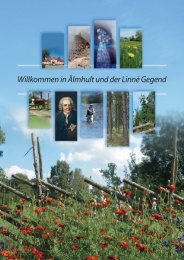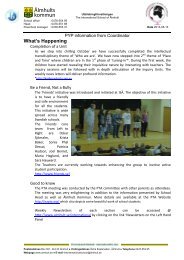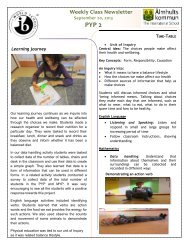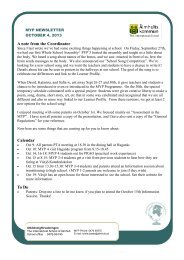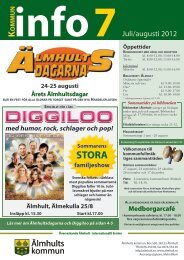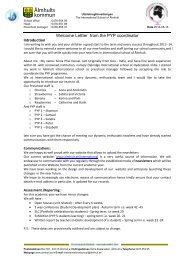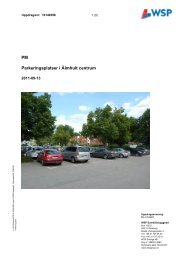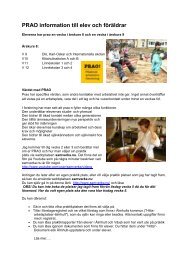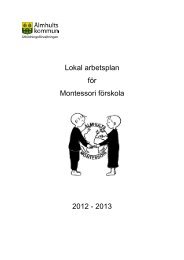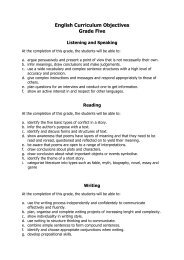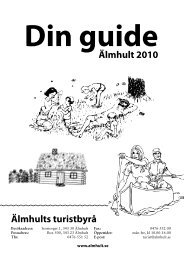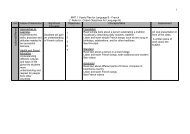MYP X XXXXXXX Yearly Plan
MYP X XXXXXXX Yearly Plan
MYP X XXXXXXX Yearly Plan
You also want an ePaper? Increase the reach of your titles
YUMPU automatically turns print PDFs into web optimized ePapers that Google loves.
<strong>MYP</strong> 4 Geography <strong>Yearly</strong> <strong>Plan</strong><br />
Unit AOI Significant<br />
Concepts<br />
ATL: Analyzing<br />
skills, research<br />
skills.<br />
DevelopmeWhat is<br />
nt?<br />
Unit Q: What is<br />
development?<br />
Students will<br />
use a range of<br />
indicators to<br />
analyse world<br />
patterns of<br />
development<br />
and go on to<br />
evaluate the<br />
effectiveness of<br />
similar<br />
indicators in<br />
assessing the<br />
quality of life of<br />
different people<br />
in particular<br />
locations.<br />
Objectives Concepts/Skills Assessment<br />
A1-2<br />
B-T1<br />
B-P3-4<br />
B-C6<br />
B-S1<br />
B-S7<br />
B-G1-6<br />
C-T1-3<br />
C-A2<br />
C-D1-2<br />
D1-3<br />
What is development? What factors do we need to<br />
consider?<br />
•Explain why it is difficult to agree a definition of<br />
'development' in a geographical context<br />
•identify development issues in the school's local area<br />
•generate their own appropriate geographical enquiry<br />
questions<br />
•analyse photographs of contrasting localities to identify<br />
similarities and differences in the quality of life of residents<br />
•explain how development occurs at different scales and in<br />
all localities<br />
• describe and explain how countries are linked in a global<br />
context<br />
How do we measure development and identify<br />
differences?<br />
Why are different perspectives important?<br />
Presentation on<br />
research<br />
Answers to study<br />
questions
Tourism:<br />
Good or<br />
Bad?<br />
Env: What is the<br />
impact of tourism<br />
on our<br />
environment?<br />
Unit Question: Is<br />
tourism good or<br />
bad?<br />
Students will<br />
examine the<br />
changing<br />
patterns, and<br />
the processes<br />
that cause<br />
them, in one<br />
particular<br />
economic<br />
activity -<br />
tourism.<br />
A1-2<br />
B-P1-4<br />
B-G1-7<br />
C-T1-4<br />
D1-3<br />
Through two case studies in contrasting economic contexts<br />
pupils assess the social, economic and environmental costs<br />
and benefits of this rapidly expanding industry. They also<br />
investigate aspects of sustainability and its implications for<br />
the management of tourist resorts in the future.<br />
There are opportunities for pupils to analyse data and select<br />
their own methods for representing it.<br />
These questions will guide the students learning;<br />
1) What is tourism? How important is tourism as an<br />
economic activity?<br />
2) How and why is the tourist industry changing?<br />
Analyse statistics<br />
about the contribution<br />
tourism makes to<br />
selected MEDCs and<br />
LEDCs. Present this<br />
information using<br />
appropriate maps,<br />
graphs and diagrams,<br />
and to describe and<br />
suggest explanations<br />
for it.<br />
Mini-enquiry on a local<br />
resort.<br />
3) What is the impact of the tourist agency? Good or<br />
bad?
Virtual<br />
Volcanoes<br />
and<br />
Internet<br />
Earthquak<br />
es<br />
ATL<br />
Guiding Q: How<br />
can using the<br />
internet increase<br />
my knowledge of<br />
tectonic activity?<br />
Students will<br />
learn how to<br />
use the internet<br />
to research the<br />
occurrence of<br />
tectonic events<br />
and the impact<br />
of these<br />
processes in<br />
countries at<br />
different states<br />
of economic<br />
development.<br />
They will use a<br />
more analytical<br />
approach than<br />
during the<br />
previous <strong>MYP</strong> 2<br />
unit.<br />
A1-2<br />
B-P1-4<br />
B-S6-7<br />
B-G3<br />
B-G5-6<br />
C-T1-4<br />
C-A1-2C-<br />
D1-2<br />
C-I2<br />
D1-4<br />
What is a real volcano like?<br />
Explain to pupils that they are to carry out a 'virtual' field visit<br />
to Stromboli (locate on an atlas map) using an internet<br />
website at www.educeth.ethz.ch/stromboli/. The purpose of<br />
the 'visit' is to gather relevant information to produce an A4-<br />
size brochure of Stromboli's geographical features for tourists<br />
who visit the volcano. Focus: details of altitude, relief,<br />
Mediterranean vegetation, hazards, eruption evidence,<br />
settlements and other human features.<br />
Are all volcanoes identical?<br />
Investigate a recent volcanic eruption, in groups, using a<br />
range of appropriate resources and to consider the nature of<br />
the eruption (explosive/gentle), and its products, e.g. lava,<br />
ash, pyroclastics. Distinguish between local effects, e.g. ash<br />
falls, lava flows, and global effects, eg climate, and shortand<br />
longer-term effects. Share and compare their findings in<br />
a table<br />
These questions will also guide student learning during the<br />
unit:<br />
Where do earthquakes and volcanoes occur? What<br />
causes earthquakes and volcanoes? How do people live<br />
with earthquakes and volcanoes?<br />
Leaflet<br />
Presentation of<br />
findings using correct<br />
tools.<br />
Write up findings in the<br />
style of a newspaper<br />
report, emphasising<br />
the sequence of<br />
events, and the effects<br />
on buildings,<br />
infrastructure and<br />
people.<br />
<strong>Plan</strong> and organise a<br />
piece of extended<br />
writing entitled 'Living<br />
on the earth's plate<br />
margins'.
The Global<br />
Fashion<br />
Industry<br />
Env:<br />
Guiding Q: How<br />
does the fashion<br />
industry influence<br />
economic activity<br />
around the world?<br />
Students will<br />
develop their<br />
understanding<br />
of the global<br />
nature of<br />
economic<br />
activity and<br />
development<br />
through a study<br />
of the fashion<br />
industry.<br />
A1-2<br />
B-C5-6<br />
B-S1-5<br />
B-S7<br />
B-G2-3<br />
B-G5-7<br />
C-T1-4<br />
D1-4<br />
Students will investigate the interdependence between<br />
people, places and environments in this industry and through<br />
this study begin to understand the concept of globalisation,<br />
and i.e. what happens in one part of the world affects people<br />
everywhere.<br />
These study questions will guide student learning throughout<br />
the unit:<br />
1. What is meant by the global fashion industry?<br />
2. How does the fashion industry connect people around the<br />
globe?<br />
3. How does the world trade work? How does this affect the<br />
countries involved? How have trade patterns changed?<br />
4. What do we mean by globalisation?<br />
5. How does globalisation affect the fashion industry?<br />
6. How does globalisation affect people at a global level?<br />
What happens if the chain is broken?<br />
7. Who are the winners and losers in the globalisation<br />
progress? Is this fair?<br />
8. What might the future be like?<br />
Compare differences<br />
in hourly rates of pay<br />
between selected<br />
countries for the<br />
production of<br />
clothing/footwear.<br />
Write up the results as<br />
an article for a<br />
newspaper entitled<br />
'Who's the fashion<br />
victim?'<br />
A piece of extended<br />
writing which: explains<br />
what globalisation is<br />
and what its effects<br />
are; considers the<br />
extent to which effects<br />
are good or bad;<br />
makes predictions for<br />
the future; and<br />
considers the issue of<br />
sustainable<br />
development.



